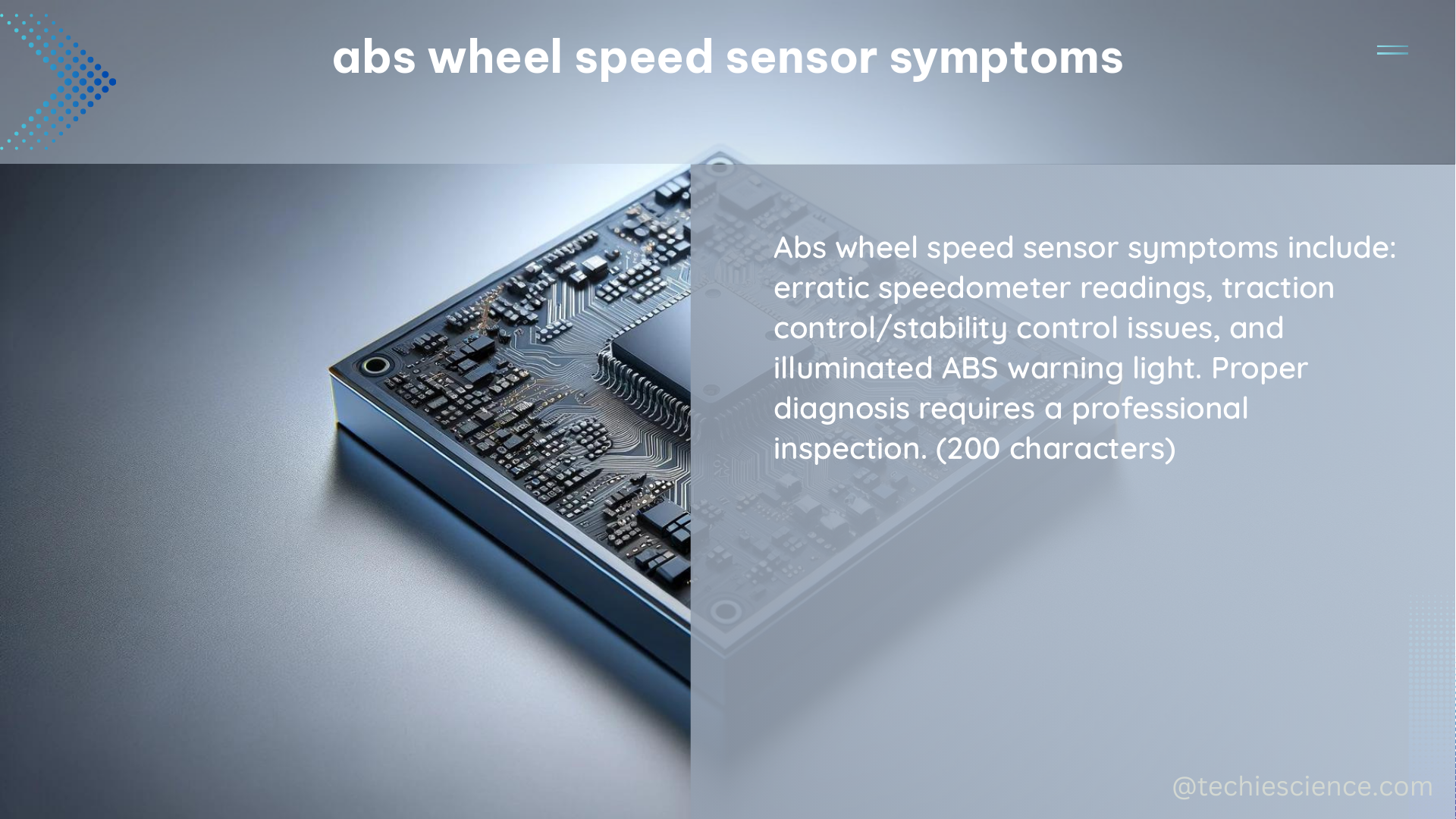The wheel speed sensor, also known as the ABS sensor, is a critical component in the Anti-lock Braking System (ABS) and other vehicle dynamics systems. It is responsible for recording the speed of its respective wheel and sending the data to the ABS module. A faulty wheel speed sensor can exhibit various symptoms, including an illuminated ABS warning light, unresponsive ABS, failed traction and stability control, a pulsating brake pedal, and a broken speedometer.
Illuminated ABS Warning Light
The ABS warning light is a small yellow or orange light on your dashboard. If the speed sensors in your ABS are faulty, they’ll most likely stay on until you replace the speed sensors. The ABS warning light is typically triggered when the ABS control module detects an issue with one or more wheel speed sensors. According to the Society of Automotive Engineers (SAE), the ABS warning light should illuminate when the ABS system detects a fault with a wheel speed sensor that exceeds a voltage threshold of 0.5 volts or a frequency threshold of 0.5 Hz.
Unresponsive ABS

Without a functional ABS sensor, your ABS control module won’t receive any data about your vehicle’s wheel speed. This will force your entire anti-lock braking system to shut down, leaving your wheels at risk of locking. The ABS system relies on the wheel speed sensors to detect when a wheel is about to lock up during heavy braking. If the sensors are not providing accurate data, the ABS system will not be able to modulate the brake pressure to prevent wheel lockup.
Failed Traction and Stability Control
The wheel speed sensors also provide data to the vehicle’s traction control and stability control systems. If the sensors are malfunctioning, these systems will not be able to function properly. Traction control uses the wheel speed sensors to detect wheel slip and apply the brakes or reduce engine power to regain traction. Stability control uses the wheel speed sensors to detect vehicle yaw and apply individual wheel brakes to keep the vehicle stable. Without accurate wheel speed data, these systems will not be able to operate as intended.
Pulsating Brake Pedal
A pulsating brake pedal is another common symptom of a faulty wheel speed sensor. The ABS system uses the wheel speed sensors to detect when a wheel is about to lock up. When this happens, the ABS system will rapidly apply and release the brakes to that wheel to prevent lockup. If the wheel speed sensors are not providing accurate data, the ABS system may incorrectly detect wheel lockup, causing the brake pedal to pulse.
Broken Speedometer
The wheel speed sensors also provide data to the vehicle’s speedometer. If one or more of the sensors is malfunctioning, the speedometer may display inaccurate or erratic readings. This is because the speedometer relies on the wheel speed data to calculate the vehicle’s speed.
Wheel Speed Sensor Operation
The wheel speed sensors are positioned directly above the impulse wheel, which is connected to the wheel hub or drive shaft. The pole pin, surrounded by a winding, connects to a permanent magnet whose magnetic effect extends to the pole wheel. The rotation of the impulse wheel and the resulting switching from tooth to tooth space brings about a change in the magnetic flow caused by the pole pin and winding. This changing magnetic field induces a quantifiable, or measurable, alternating voltage in the winding. The frequency and amplitudes of this alternating voltage are in relation to the wheel speed.
There are two main types of wheel speed sensors: active and passive. Active sensors require a supply voltage to operate and generate an output signal. Passive sensors, on the other hand, operate without an additional supply voltage and generate an output signal based on the changing magnetic field.
Testing Wheel Speed Sensors
To test the wheel speed sensor, you can use a scanner that can communicate with the ABS module and display the live data from the wheel speed sensors. This will allow you to see if the sensor is providing the expected output signal and if the signal is changing as the wheel rotates.
When testing the wheel speed sensor, you should check the following:
- Sensor voltage output: Measure the voltage output of the sensor while the wheel is rotating. The voltage should be within the manufacturer’s specified range, typically between 0.5 and 5 volts.
- Sensor frequency: Measure the frequency of the sensor output signal. The frequency should increase as the wheel speed increases, and the frequency should be within the manufacturer’s specified range.
- Sensor resistance: Measure the resistance of the sensor winding. The resistance should be within the manufacturer’s specified range, typically between 1 and 2 kΩ.
- Sensor wiring: Check the wiring between the sensor and the ABS module for any damage or loose connections.
If the sensor is not providing the expected output signal or the wiring is damaged, the sensor will need to be replaced.
Reference:
– Symptoms of a Bad Wheel Speed Sensor and Other FAQ
– Check & change ABS sensor
– Brake Disc ABS

The lambdageeks.com Core SME Team is a group of experienced subject matter experts from diverse scientific and technical fields including Physics, Chemistry, Technology,Electronics & Electrical Engineering, Automotive, Mechanical Engineering. Our team collaborates to create high-quality, well-researched articles on a wide range of science and technology topics for the lambdageeks.com website.
All Our Senior SME are having more than 7 Years of experience in the respective fields . They are either Working Industry Professionals or assocaited With different Universities. Refer Our Authors Page to get to know About our Core SMEs.